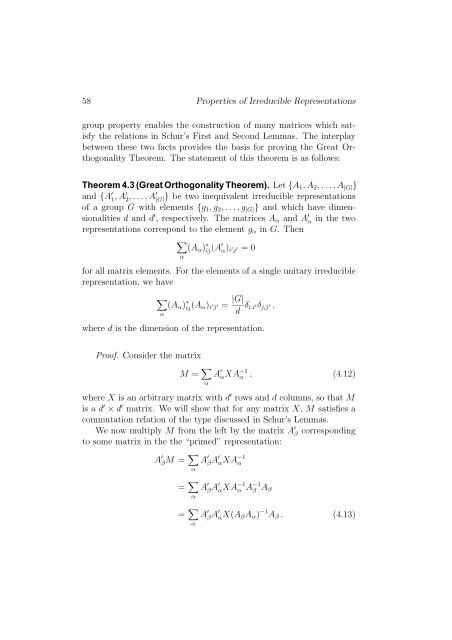Chapter 4 Properties of Irreducible Representations
Chapter 4 Properties of Irreducible Representations
Chapter 4 Properties of Irreducible Representations
You also want an ePaper? Increase the reach of your titles
YUMPU automatically turns print PDFs into web optimized ePapers that Google loves.
58 <strong>Properties</strong> <strong>of</strong> <strong>Irreducible</strong> <strong>Representations</strong><br />
group property enables the construction <strong>of</strong> many matrices which satisfy<br />
the relations in Schur’s First and Second Lemmas. The interplay<br />
between these two facts provides the basis for proving the Great Orthogonality<br />
Theorem. The statement <strong>of</strong> this theorem is as follows:<br />
Theorem 4.3 (Great Orthogonality Theorem). Let {A 1 ,A 2 ,...,A |G| }<br />
and {A ′ 1,A ′ 2,...,A ′ |G|<br />
} be two inequivalent irreducible representations<br />
<strong>of</strong> a group G with elements {g 1 ,g 2 ,...,g |G| } and which have dimensionalities<br />
d and d ′ , respectively. The matrices A α and A ′ α in the two<br />
representations correspond to the element g α in G. Then<br />
∑<br />
(A α ) ∗ ij(A ′ α) i ′ j ′ =0<br />
α<br />
for all matrix elements. For the elements <strong>of</strong> a single unitary irreducible<br />
representation, we have<br />
∑<br />
α<br />
(A α ) ∗ ij(A α ) i ′ j ′ = |G|<br />
d δ i,i ′δ j,j ′ ,<br />
where d is the dimension <strong>of</strong> the representation.<br />
Pro<strong>of</strong>. Consider the matrix<br />
M = ∑ α<br />
A ′ αXA −1<br />
α , (4.12)<br />
where X is an arbitrary matrix with d ′ rows and d columns, so that M<br />
is a d ′ × d ′ matrix. We will show that for any matrix X, M satisfies a<br />
commutation relation <strong>of</strong> the type discussed in Schur’s Lemmas.<br />
We now multiply M from the left by the matrix A ′ β corresponding<br />
to some matrix in the the “primed” representation:<br />
A ′ βM = ∑ α<br />
A ′ βA ′ αXA −1<br />
α<br />
= ∑ α<br />
A ′ βA ′ αXA −1<br />
α A −1<br />
β A β<br />
= ∑ α<br />
A ′ βA ′ αX(A β A α ) −1 A β . (4.13)













